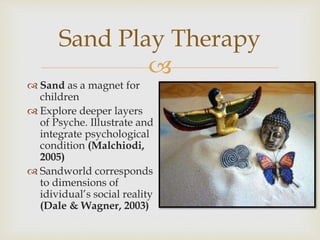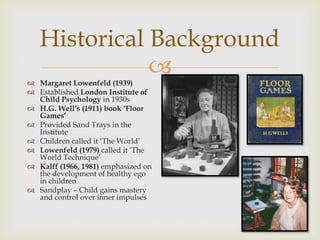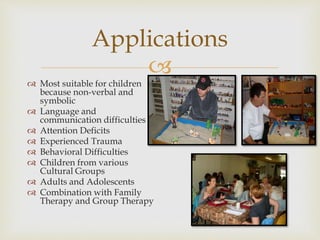Sand Play Therapy
- 1. Sand Play Therapy Natasha Gupta
- 2. Counseling “Counseling is a professional relationship that empowers diverse individuals, families, and groups to accomplish mental health, wellness, education, and career goals” (20/20: A Vision for the Future of Counseling Group, 2010)
- 3. Children’s play is not mere sport. It is full of meaning and import - Freobel, 1903
- 4. Expressive Therapies Expressive therapies are defined as the use of art, music, dance/movement, drama, poetry/creative writing, play, and sandtray within the context of psychotherapy, counseling, rehabilitation, or health care (Malchiodi, 2005) Unique Properties Limitations
- 5. Counseling as a Creative Art Several of the expressive therapies are also considered “creative arts therapies” (National Coalition of Creative Arts Therapies Associations, 2004a) Creative art (Gladding, 1992) Actual practice differs from theory (Cavanagh, 1982)
- 6. Art Therapy Therapy – Aim to bring about favourable changes (Ulman, 1961) Art - a way of stating mixed, poorly understood feelings in an attempt to bring them into clarity and order (Naumberg, 1958) Art Therapy - Man’s most fundamental thoughts and feelings, derived from the unconscious, reach expression in images rather than words. (Naumberg, 1958)
- 7. Sand Play Therapy Sand as a magnet for children Explore deeper layers of Psyche. Illustrate and integrate psychological condition (Malchiodi, 2005) Sandworld corresponds to dimensions of idividual’s social reality (Dale & Wagner, 2003)
- 8. Sand Play Therapy Three Dimensional Scene Two trays of Sand – Dry and Wet Sand, with a container of water nearby Miniatures – People, Animals, Buildings, Vegetations, Vehicles, Structures, Natural Objects, Symbolic Objects Dimension allows view in one glance Interior painted Blue – Gives impression of water or sky when sand moved Many kinds of sand colour serving different symbolic functions
- 9. Historical Background Margaret Lowenfeld (1939) Established London Institute of Child Psychology in 1930s H.G. Well’s (1911) book ‘Floor Games’ Provided Sand Trays in the Institute Children called it ‘The World’ Lowenfeld (1979) called it ‘The World Technique’ Kalff (1966, 1981) emphasized on the development of healthy ego in children Sandplay – Child gains mastery and control over inner impulses
- 10. Method Sandplay – Process, Sand Tray – Medium, Sand World – Finished Product Counselor invites child to play with sand and choose miniatures Miniature – Unique physical structure and symbolic meaning Two central Stages - Construction of Sand Picture - Sharing of story or narrative about sand picture
- 11. Common Stages Chaos - Dump Objects - No Order - Intermingling of Sand and Toys - Toys not chosen deliberately Struggle - Many Battles - No Winner, Dead left in a heap in the corner - Gradually battle becomes more intense, organized, balanced - Adversaries not killed, imprisoned - Hero emerges
- 12. Common Stages Resolution - Getting back to normal - Order and Balanced restored - Resolution of Problem - Accepting place in the outer world - “I don’t need to come anymore” - Wholeness or Completion demonstrated by squares, rectangles, circles
- 13. Role of the Counselor Do nothing Harder to do nothing than do something Unconditional Positive Regards Minimal Verbalizations Allow the client to feel ‘safe and free’ Images come from collective unconscious rather than ego (Jung) Knowledge of the language of symbols Draw quick sketch or take slide photographs Show them during termination for review and discussion
- 14. Applications Most suitable for children because non-verbal and symbolic Language and communication difficulties Attention Deficits Experienced Trauma Behavioral Difficulties Children from various Cultural Groups Adults and Adolescents Combination with Family Therapy and Group Therapy
- 15. Zhou, D. (2009). A Review of Sandplay Therapy. International Journal of Psychological Studies, Vol 1 (2) Gladding, S.T. (2014). Counseling: A Comprehensive Profession, Pearson Publication Gladding, S.T (1992). Counseling as an Art: The Creative arts in Counseling. Malchiodi, C.A. (2003). Handbook of Art Therapy. The Guilford Publications Malchiodi, C.A. (2005). Expressive Therapies: History, Theory and Practice. Guilford Publications Allan, J., Berry, P. (1987). Elementary School Guidance & Counseling, American School Counselor Association, Vol 21 (4), 300-306 Dalley, T. (1984). Art as a therapy: An introduction to the use of art as a therapeutic technique. Routledge Publication References















